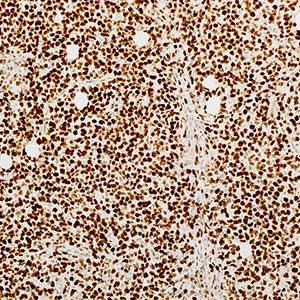
FOXP1 (EP137)

Diffuse large B-cell lymphoma (DLBCL) most likely represents different clinicopathologic entities, which are difficult to separate using standard technique.1,2 Diffuse large B-cell lymphoma (DLBCL) can be divided into the subtypes of germinal center B-cell–like (GCB), activated B-cell–like (ABC), and unclassified DLBCL.2-4 The GCB and ABC subtypes have different pathogenetic mechanisms that will impact the development of targeted therapies.3 Despite the robustness of gene expression profiling (GEP) in subclassifying DLBCL, GEP techniques are not applicable to the routine clinical practice due to the substantial time, technological expertise, and scarce resources required. Therefore, it is beneficial for the translational application of the GEP classification into protein expression by tumor cells to be developed through immunohistochemical (IHC) staining of formalin-fixed, paraffin-embedded tissues. Different approaches using immunophenotypic algorithms with small panels of antibody biomarkers have been developed to translate the robust information from molecular studies into a routine clinical platform,5-9 using antibodies against CD10, BCL6, MUM1/IRF4, GCET1, FoxP1, LMO2, and BCL2. Therefore, FoxP1 is useful in subclassification of DLBCL and a high cutoff (≥80%) for FoxP1 is needed to achieve high specificity for the ABC subtype.
